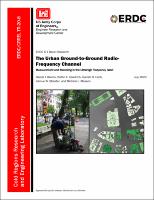Please use this identifier to cite or link to this item:
https://hdl.handle.net/11681/37554| Title: | The urban ground-to-ground radio-frequency channel : measurement and modeling in the ultrahigh frequency band |
| Authors: | Breton, Daniel J. Haedrich, Caitlin E. Hoch, Garrett R. Streeter, Samuel S. Maxson, Michele L. |
| Keywords: | Buildings Cities and towns Diffuse Model Propagation Radio frequency Radio measurements Scattering Ultrahigh-frequency Urban |
| Publisher: | Cold Regions Research and Engineering Laboratory (U.S.) Engineer Research and Development Center (U.S.) |
| Series/Report no.: | Technical Report (Engineer Research and Development Center (U.S.)) ; no. ERDC/CRREL TR-20-8 |
| Abstract: | Ground-to-ground radio communication and sensing within the urban environment is challenging because line of sight between transmitter and receiver is rarely available. Therefore, radio links are often critically reliant on reflection and scattering from built structures. Little is known about the scattering strength of different buildings or whether such differences are important to the urban ground-to-ground channel.We tested the hypotheses that (1) diffuse scattering from built structures significantly impacts the urban channel and (2) scattering strength of urban structures varies with surface roughness and materials. We tested these hypotheses by measuring urban channels in Concord, New Hampshire, and Boston, Massachusetts, and via channel-modeling efforts with three-dimensional representations of the urban environment. Direct comparison between measured and modeled channels suggest that both of these hypotheses are true. Further, it appears that ray-tracing approaches underestimate the complexity of urban channels because these approaches lack the physical processes to correctly assess the power incident on and scattered from built structures. We developed a radio-geospatial model that better accounts for incident power on both directly visible and occluded buildings and show that our model predictions compare more favorably with measured channels than those channels predicted via typical ray-tracing approaches. |
| Description: | Technical Report |
| Gov't Doc #: | ERDC/CRREL TR-20-8 |
| Rights: | Approved for Public Release; Distribution is Unlimited |
| URI: | https://hdl.handle.net/11681/37554 http://dx.doi.org/10.21079/11681/37554 |
| Appears in Collections: | Technical Report |
Files in This Item:
| File | Description | Size | Format | |
|---|---|---|---|---|
| ERDC-CRREL TR-20-8.pdf | 4.81 MB | Adobe PDF |  View/Open |